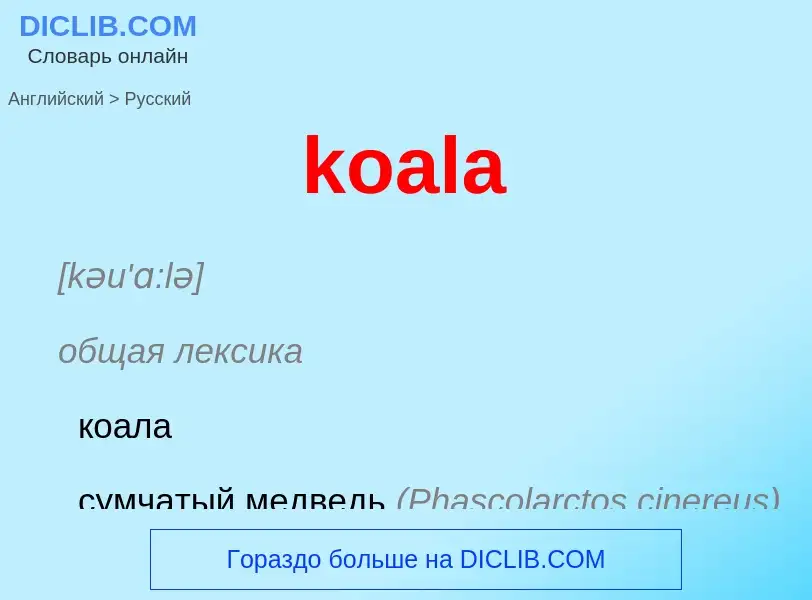Traducción y análisis de palabras por inteligencia artificial ChatGPT
En esta página puede obtener un análisis detallado de una palabra o frase, producido utilizando la mejor tecnología de inteligencia artificial hasta la fecha:
- cómo se usa la palabra
- frecuencia de uso
- se utiliza con más frecuencia en el habla oral o escrita
- opciones de traducción
- ejemplos de uso (varias frases con traducción)
- etimología
koala - traducción al ruso
[kəu'ɑ:lə]
общая лексика
коала
сумчатый медведь (Phascolarctos cinereus)
существительное
зоология
коала
сумчатый медведь (Phascolarctos cireneus)
общая лексика
коала (Phascolarctos cinereus)
Wikipedia

The koala or, inaccurately, koala bear (Phascolarctos cinereus), is an arboreal herbivorous marsupial native to Australia. It is the only extant representative of the family Phascolarctidae and its closest living relatives are the wombats. The koala is found in coastal areas of the mainland's eastern and southern regions, inhabiting Queensland, New South Wales, Victoria, and South Australia. It is easily recognisable by its stout, tailless body and large head with round, fluffy ears and large, spoon-shaped nose. The koala has a body length of 60–85 cm (24–33 in) and weighs 4–15 kg (9–33 lb). Fur colour ranges from silver grey to chocolate brown. Koalas from the northern populations are typically smaller and lighter in colour than their counterparts further south. These populations possibly are separate subspecies, but this is disputed.
Koalas typically inhabit open Eucalyptus woodland, as the leaves of these trees make up most of their diet. This eucalypt diet has low nutritional and caloric content and contains toxins that deter most other mammals from feeding on it. Koalas are largely sedentary and sleep up to twenty hours a day. They are asocial animals, and bonding exists only between mothers and dependent offspring. Adult males communicate with loud bellows that intimidate rivals and attract mates. Males mark their presence with secretions from scent glands located on their chests. Being marsupials, koalas give birth to underdeveloped young that crawl into their mothers' pouches, where they stay for the first six to seven months of their lives. These young koalas, known as joeys, are fully weaned around a year old. Koalas have few natural predators and parasites, but are threatened by various pathogens, such as Chlamydiaceae bacteria and koala retrovirus.
Because of its distinctive appearance, the koala along with the kangaroos are recognised worldwide as symbols of Australia. They were hunted by Indigenous Australians and depicted in myths and cave art for millennia. The first recorded encounter between a European and a koala was in 1798, and an image of the animal was published in 1810 by naturalist George Perry. Botanist Robert Brown wrote the first detailed scientific description of the koala in 1814, although his work remained unpublished for 180 years. Popular artist John Gould illustrated and described the koala, introducing the species to the general British public. Further details about the animal's biology were revealed in the 19th century by several English scientists. Koalas are listed as a vulnerable species by the International Union for Conservation of Nature. Among the many threats to their existence are habitat destruction caused by agriculture, urbanisation, droughts, and associated bushfires, some related to climate change. In February of 2022, the koala was officially listed as endangered in the Australian Capital Territory, New South Wales, and Queensland.








![canines]], [[incisor]]s canines]], [[incisor]]s](https://commons.wikimedia.org/wiki/Special:FilePath/Machoires de koala avec dents.png?width=200)


![US President [[Barack Obama]] with a koala in [[Brisbane]], [[Australia]] US President [[Barack Obama]] with a koala in [[Brisbane]], [[Australia]]](https://commons.wikimedia.org/wiki/Special:FilePath/President Obama holding a koala 3.jpg?width=200)
